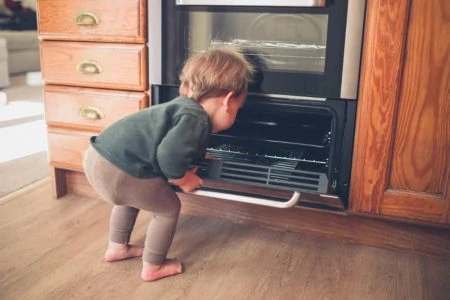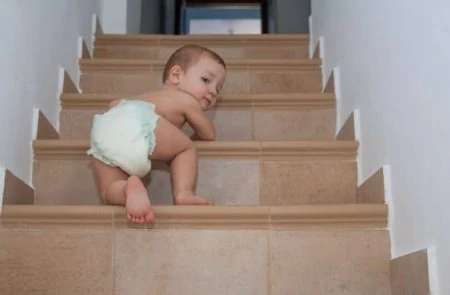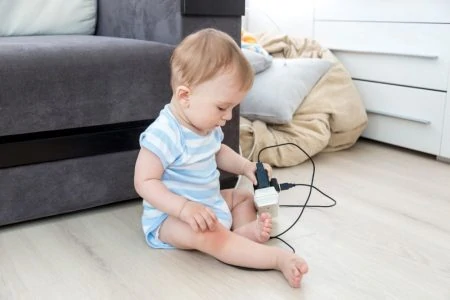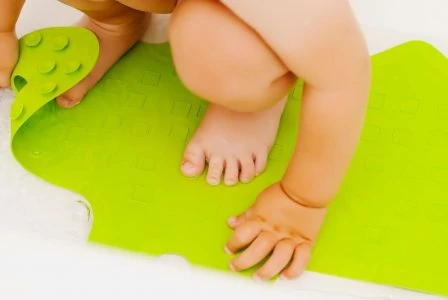We have all seen it happen. One minute your baby is happily playing on the floor, and the next, they are scaling the sofa like a tiny mountaineer. When we think of babyproofing, we usually picture outlet covers and cabinet locks. But did you know windows are one of the biggest hidden hazards in the home?
We know little escape artists often have skills that would make Houdini jealous. Sadly, over 5,000 children are injured every year from window falls (1). That statistic does not even include injuries from broken glass or the strangulation risks posed by dangling blind cords.
Window safety must be a priority in your babyproofing plan. We researched the most effective ways to secure your view so you can let the sunshine in without the stress. Here is how to keep your toddler safe.
Key Takeaways
- Identify your window type: Different styles (awning, casement, hung, and sliding) require specific babyproofing hardware and techniques.
- Screens provide false security: Insect screens are designed to keep bugs out, not children in; they easily pop out under the weight of a toddler.
- Limit the opening: Install window stops or locks to ensure windows cannot open more than four inches to prevent falls.
- Eliminate cord hazards: Strangulation is a silent risk; use cordless blinds or secure anchors to keep cords high and out of reach.
Types of Windows
The first step to securing your home is identifying exactly what you are working with. Different windows use unique opening mechanisms, meaning you will need specific babyproofing methods for each one.
Here is a quick breakdown of the common styles:
1. Awning Windows
Awning windows crank open on a top hinge, pushing the glass outward from the bottom. Because they create an angle, they offer excellent ventilation and rain protection, but the crank mechanism can be a temptation for curious hands.
2. Casement Windows
Casement windows are similar to awnings, but they are hinged on the side and crank outward to the left or right.
While they are fantastic for weather-tightness, they are less common in standard nurseries because they have moving mechanical parts that can break, and they rarely accommodate standard window A/C units (2).
3. Hung Windows
Hung windows are the most common style found in modern homes. They rely on a sliding sash mechanism.
Single-hung windows have a fixed top pane and a bottom sash that slides up. Double-hung windows are more versatile, allowing both the top and bottom sashes to slide vertically. Some modern versions even tilt inward for easier cleaning.
4. Sliding Windows
Think of these as miniature sliding glass doors. Also known as gliders, these windows have sashes that slide horizontally along a track.
They are popular for their ease of use and energy efficiency, but that smooth gliding motion makes them incredibly easy for a toddler to open without much force.
Why Window Screens Are Not Babyproof
This is the most common misconception in window safety. You might see a screen and think there is a barrier between your child and the outdoors.
However, window screens are designed solely to keep insects out. They are flimsy, lightweight mesh held in place by a thin frame. If a toddler leans against a screen, it can easily pop out or tear. Never rely on a screen to prevent a fall.
Setting Boundaries with Children
Hardware is essential, but verbal boundaries are just as important. Even young toddlers can begin to understand “No” when it comes to dangerous areas.
Consistency is your best friend here. If your child climbs on the sill, calmly remove them immediately. You might have to do it ten times in a row, but eventually, they will learn that the window is a “no-go” zone.
Here are four tips for establishing these rules:
- Have a plan: Decide strictly where the boundaries are so you do not hesitate when your child tests them.
- Keep it simple: Use short phrases like “Windows are for looking, not touching.”
- Be firm but warm: You do not need to yell to be serious. A calm, stern voice gets the message across without causing fear.
- Expect pushback: Your child will likely get upset when you move them away from the exciting window. That is okay. Validate their feelings, but hold the boundary firmly.
Furniture Placement and Hazards
Sometimes the window itself is secure, but the environment creates a risk. If you place a crib, changing table, or toy chest right next to a window, you are essentially building a ladder for your child.
Follow these decluttering guidelines:
- Rearrange the room: Move climbable furniture away from windows. This prevents your child from reaching the latch or the glass.
- Clear the sill: Remove tempting items like toys or bright decorations from the windowsill to reduce the urge to climb.
- Check for projectiles: Store hard toys (blocks, marbles, cars) away from the window area to prevent the glass from being smashed during playtime.
Babyproofing with Window Locks
Simple window locks are often the first line of defense. While most windows come with a factory latch, these are usually designed for weather sealing, not child safety.
Retrofitting your windows with child-proof locks prevents them from being opened by little fingers. You can install keyed locks for maximum security, though you must keep the key accessible to adults in case of emergency.
If you choose permanent locks, remember that you lose the ability to open the window for fresh air easily. If ventilation is important to you, you will want to combine locks with window stops.
Babyproofing with Window Stops
If you want a fresh breeze without the risk of a fall, window stops are the perfect solution. They allow the window to open slightly but prevent it from opening wide enough for a child to slip through.
Here are two popular options:
1. Window Wedge

A window wedge is an adjustable stop that works on hung and sliding windows. You position the wedge in the track or against the sash to limit movement.
This allows you to crack the window for airflow while physically blocking it from opening further. It is a cost-effective and easy-to-install method.
Safety Tip
2. Security Bar
Also known as Charley bars, these are typically used for sliding glass doors but work well for sliding windows too.
You install the bar in the track to prevent the window from sliding open. Place the bar high up on the window frame so it is completely out of your child’s reach. Many models are adjustable, so you can lock the window in a slightly open position for ventilation.
Babyproofing with Window Film
Toddlers have surprisingly strong arms, and throwing toys is a favorite pastime. Standard window glass can shatter into dangerous, sharp shards if hit by a hard object.
Window safety film is a transparent sheet you apply directly to the glass. While it does not prevent the window from breaking, it holds the shattered pieces together, much like a car windshield. This prevents glass from exploding inward and injuring your child.
Sunny Safety
Babyproofing Awning and Casement Windows
Because these windows crank outward, standard stops and wedges often do not work. You need specific hardware to secure them effectively.
1. Window Guards

Window guards are metal grills or bars that screw into the window frame. They create a physical barrier that allows full airflow while making it impossible for a child to fall out.
Look for guards that include a quick-release mechanism for adults. This is vital for fire safety; you need to be able to remove the guard instantly in an emergency, but the mechanism should be too complex for a child to operate.
2. Remove the Crank
The simplest DIY fix for crank windows is to remove the handle entirely. Most cranks are held on by a small set screw.
Once you remove the handle, the window cannot be opened. Keep the handle on a high shelf or in a drawer nearby so you can use it when needed, but your child remains safe in the meantime.
Babyproofing Window Cords
Blind cords are one of the most overlooked yet deadly hazards in a home. The CPSC reports that nearly one child a month dies from window cord strangulation (3).
The gold standard for safety is switching to cordless blinds. If that is not in your budget right now, you must secure the existing cords immediately:
- Use cord cleats: Install plastic or metal cleats high up on the wall and wrap the excess cord tightly around them.
- Cut the loops: If your blinds have looped cords, cut the loop to create two separate strands and install tassels at the ends.
- Retrofit kits: You can buy inexpensive wind-up devices that encase the cord and keep it short.
Babyproofing Windowsills
Windowsills are magnets for bumps and bruises. They often have sharp corners and are at the perfect height for a toddler to hit their head.
To protect your little one, apply cushioned corner guards to the sharp edges of the sill. This softens the blow if a fall occurs.
Additionally, keep an eye on low windowsills. If a sill is less than 24 inches from the floor, it is inviting for a child to stand on. Since you cannot raise the window, your reliance on window stops and strict boundaries becomes even more critical here.
Basement Window Safety
Basement windows present a unique challenge: keeping kids in, but allowing you to get out during a fire.
If your basement is a living space or playroom, ensure your windows meet egress codes. This means they are large enough for an adult to climb through.
Never block a basement window with heavy furniture or permanent bars that cannot be opened from the inside. If the window is high up on the wall, keep a sturdy step stool or ladder stored nearby (but not directly under the window) to ensure an escape route is always available for adults and older children.
Babyproofing Windows FAQs
Babyproofing Windows: A Quick Review
Securing your windows does not have to be complicated. With a few pieces of hardware and some strategic rearranging, you can breathe easy. Here is your action plan:
- Identify the type: Check if your windows slide, crank, or hang to buy the right gear.
- Spot the hazards: crawling around your room at toddler height helps you spot dangers like low sills or dangling cords.
- Set a budget: You do not have to replace every window. Inexpensive wedges and cord cleats are highly effective.
- Install and test: Put your locks and guards in place, then give them a firm tug to ensure they can withstand a toddler’s strength.
- Review regularly: As your child grows taller and stronger, re-evaluate your setup to ensure it is still safe.











